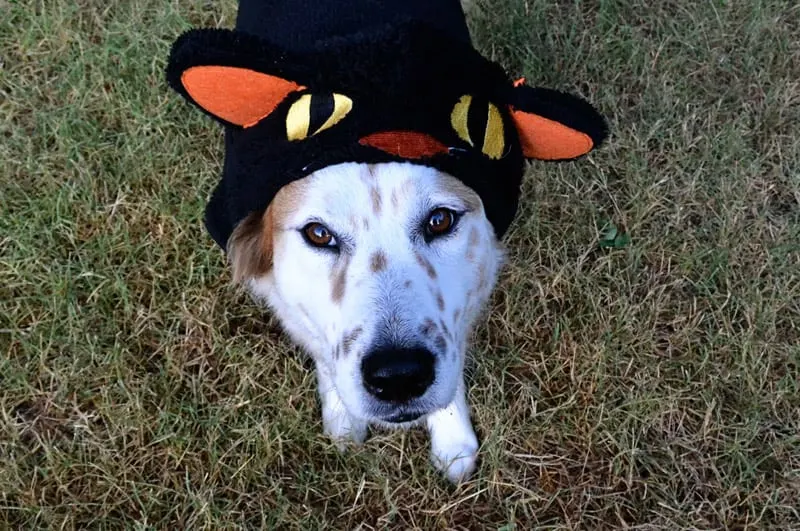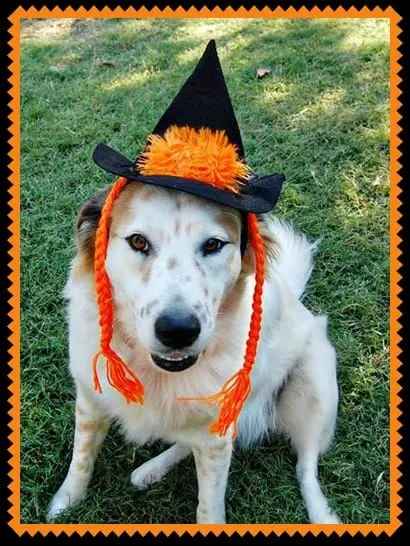The countdown is on to Halloween but the fun of the season is already underway with Halloween dog parades, costume contests, and dog festivals every weekend. For all the fun of this season, though, there are some genuinely spooky aspects when it comes to dog safety. Below we’ve got tips for you on how to keep your dog safe this Halloween season, from festival fun to greet trick or treaters at home.

13 things your dog should never do this Halloween
Never let your dog eat chocolate or sugar-free gum.
Chocolate and Halloween go hand in hand…unless your hands are paws. Remember that chocolate is toxic for dogs.
Keep your dogs away from the Halloween candy and away from discarded Halloween candy on your walks on November 1, too!
Also, sugar-free gum is concern because of the extreme danger of xylitol poisoning.
Never let your dog overindulge on any treat.
The Pet Poison Helpline notes, “Pets are indiscriminate when it comes to eating tasty treats and can gorge themselves on snacks and food meant for humans. Large ingestions of sugary, high-fat candy can lead to pancreatitis in pets. Potentially fatal, pancreatitis is inflammation of the pancreas and very painful. It may not show up for two to four days after the pet ingests the candy. Symptoms include decreased appetite, vomiting, diarrhea, lethargy, abdominal pain, and potentially, kidney failure or organ damage”
Never let your dog get close to candles.
Candles in jack-o-lanterns can easily be knocked over by an enthusiastically wagging tail, causing burns or a fire.
Opt for safer battery-lit candles for the same look without the worry.
Never let your dog eat raisins.
“Some people prefer to distribute healthy snacks instead of candy on Halloween, such as mini-boxes of raisins,” notes the Pet Poison Helpline. “These are extremely are poisonous to dogs! Very small amounts of raisins (and grapes) can cause kidney failure in dogs and, potentially, cats. When it comes to your pets, raisins deserve the same pet-proofing treatment as chocolate — stored in secure containers far from their reach. Unfortunately, some dogs develop idiosyncratic reactions at any dose — in other words, they can ingest any amount and potentially be poisoned. Therefore, any ingestion of raisins or grapes should be treated as a “poisoning” case. Symptoms include vomiting, nausea, decreased appetite, lethargy, abdominal pain, and severe kidney failure.”
Never run the risk of your dog getting lost.
Whether you plan for your dog to be in the house or trick or treating with you, you must have a current ID tag on your dog. With all the noise and confusion of trick or treaters coming to the door, dogs can become spooked and bolt from the house–so make sure your dog’s tag is current and readable.

Never take a worried dog trick or treating.
Shy dogs will not enjoy trick or treating; the combination of darkness, scary costumes, and heightened energy will make your dog anxious. A better choice for shy dogs is a fun celebration at home with just your family.
Your dog doesn’t have to be a fearful dog to prefer a quiet night at home to trick or treating. The strange masks and costumes in the darkness are frightening for many dogs.
If your dog is outgoing and would like to trick or treat, be sure you have a current ID tag on your dog (and a GPS tag is great as well) and keep your dog on a short leash.
For most dogs, the best solution on Halloween is to stay at home, securely in a bedroom with a chew, and away from the view of scary trick or treaters at your door. Leave the TV or radio on to drown out the sound of the doorbell. (Or leave off your porch light and forego the trick or treaters altogether.)
Never trick or treat without lighting on your dog.
If you plan to take your dog trick or treating with you, be sure your dog is wearing a lighted collar, lighted tag, and/or a lighted leash.
It’s all too easy for dogs to get away in the dark of night. A lighted collar can be part of your dog’s Halloween costume!
Never let your dog bolt from the house.
Too many dogs become lost on Halloween as the door opens and closes all evening.
Keep your dog in a secure room both for his safety and for that of the trick or treaters.
Never let your pets chew glow sticks.
“Pets, especially cats, love to chew on these items. Over the past year, Pet Poison Helpline received nearly 80 calls concerning pets that punctured glow sticks or glow jewelry, and 70 percent of the calls involved cats.
While not usually life-threatening, their contents can cause pain and irritation in the mouth, as well as profuse drooling and foaming at the mouth.”
Never let your dog wear a dangerous or uncomfortable costume.
Costumes with bells and small pieces that could be choking hazards should never be put on your dog. Should you costume your dog? Only if your dog is comfortable and cool–in every way–with the costume. (And we’ve got a whole post on selecting a safe Halloween costume for dogs.)
If your dog doesn’t like to wear clothes or but you’d like to costume him, consider a special Halloween collar or decorate his usual dog harness and leash.
Never put your dog in an uncomfortable costume.
Similarly, don’t put a costume that’s temperature inappropriate on your dog or one that restricts his movement. It’s not just uncomfortable; it’s dangerous.
Never let your dog eat fake spiderwebs and decorations.
Fake spiderwebs are especially a hazard for cats, who digest them and run the risk of clogged intestines. They can also be a hazard for dogs.
Never let your dog eat discarded candy wrappers.
Both on Halloween and in the days following, keep an eye out for discarded wrappers and foil that your dog can suddenly gulp.
“Generally when pets eat candy, they don’t bother to remove the wrappers. Ingestion of foil and cellophane wrappers can cause a life-threatening bowel obstruction, which if severe, can require surgical intervention to correct,” explains the Pet Poison Helpline. “Watch for vomiting, decreased appetite, not defecating, straining to defecate, or lethargy. X-rays may be necessary to diagnose this problem.”
Greeting Trick or Treaters

Halloween, with its scary masks, strange costumes, and shouting children, can be a very frightening time for dogs. With the constant opening and closing of the door to trick or treaters, it can also be a dangerous time when some dogs try to bolt–or even bite–in the confusion.
We’ve got some tips here on dealing with trick or treaters from the folks that brought you Spooky Buddies. Here are some suggestions for making sure the evening is a treat for your pup:
- If your dog likes to greet every doorbell ring with enthusiasm, work with them before Halloween night. Have several family members ring the doorbell several times in a row do your dog can get used to the noise.
- If your dog still seems to be getting over-excited and worn out greeting each trick-or-treater, put them in a quiet room with a few toys until the rush is over.
- Keep a supply of doggy treats on hand for your own pets and any four-legged trick-or-treaters who show up at your door.
- Don’t leave your dog outdoors alone while trick-or-treaters are out and about. A careless child (or adult) could forget to latch the gate when leaving your yard, giving the dog a chance to escape.
With some precautions, Halloween can be a treat…and a safe one…for both you and your dog!
- Review: Jimmy BX7 Pro Anti-Mite Vacuum Cleaner - December 16, 2024
- 🎉 GIVEAWAY: Lord of the Pets Portrait of Your Dog! - November 26, 2024
- Review: Lord of the Pets Portraits - November 17, 2024
